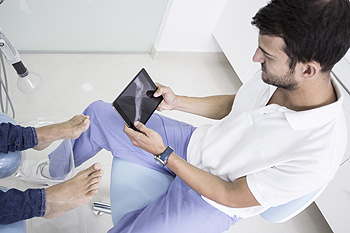
Podiatrists, specialized healthcare professionals, navigate the intricate landscape of foot and ankle care. Tasked with diagnosing, treating, and preventing a spectrum of conditions, their job encompasses addressing issues like foot deformities, injuries, and disorders related to gait. These specialists employ a diverse set of skills, from conducting thorough examinations and interpreting diagnostic tests to formulating personalized treatment plans. Qualifications for aspiring podiatrists involve completing a Doctor of Podiatric Medicine, or DPM degree, typically a four year program, following an undergraduate degree. Subsequently, a multi year residency allows them to refine clinical skills and gain hands-on experience. Podiatrists must be licensed to practice, meeting the requirements stipulated by each state. Individuals who have foot or ankle issues for any reason should contact a podiatrist who can offer the correct treatment method.
If you are dealing with pain in your feet and ankles, you may want to seek help from a podiatrist. Feel free to contact Howard Waxman, DPM from Pleasant Valley Podiatry. Our doctor can provide the care you need to keep you pain-free and on your feet.
What Is a Podiatrist?
A podiatrist is a doctor of podiatric medicine who diagnoses and treats conditions of the foot, ankle, and related structures of the leg. Your podiatrist may specialize in a certain field such as sports medicine, wound care, pediatrics, and diabetic care. Podiatrists have the ability to become board certified through training, clinical experience, and then taking an exam.
What Do Podiatrists Do?
On a daily basis, a podiatrist may perform the following activities:
It is very important that you take care of your feet. It’s easy to take having healthy feet for granted, however foot problems tend to be among the most common health conditions. Podiatrists can help diagnose and treat a variety of feet related conditions, so it is crucial that you visit one if you need assistance.
If you have any questions please feel free to contact one of our offices located in Willoughby Hills and Broadview Heights, OH . We offer the newest diagnostic and treatment technologies for all your foot and ankle needs.
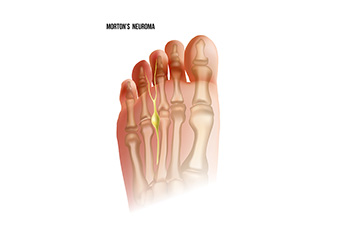
Morton's neuroma is a painful foot condition that affects the ball of the foot, most commonly occurring between the 3rd and 4th toes. It is not a true neuroma, as the name suggests, but rather a thickening of the tissue around the nerve that leads to the toes. The main symptom of Morton's neuroma is localized pain, which can vary from a mild discomfort to an intense, burning sensation. The pain is typically aggravated by walking, wearing tight or narrow shoes, or putting pressure on the affected area. Some individuals describe it as feeling like there is a pebble or a fold in their sock, even when there isn't. Tingling and numbness in the toes may also accompany the pain. People with Morton's neuroma often find relief when they remove their shoes and massage the affected area. Early diagnosis and appropriate treatment can help alleviate the pain and prevent the condition from worsening. It is suggested to seek medical attention from a podiatrist if you suspect you have Morton's neuroma.
Morton’s neuroma is a very uncomfortable condition to live with. If you think you have Morton’s neuroma, contact Howard Waxman, DPM of Pleasant Valley Podiatry. Our doctor will attend to all of your foot care needs and answer any of your related questions.
Morton’s Neuroma
Morton's neuroma is a painful foot condition that commonly affects the areas between the second and third or third and fourth toe, although other areas of the foot are also susceptible. Morton’s neuroma is caused by an inflamed nerve in the foot that is being squeezed and aggravated by surrounding bones.
What Increases the Chances of Having Morton’s Neuroma?
Morton’s neuroma is a very treatable condition. Orthotics and shoe inserts can often be used to alleviate the pain on the forefront of the feet. In more severe cases, corticosteroids can also be prescribed. In order to figure out the best treatment for your neuroma, it’s recommended to seek the care of a podiatrist who can diagnose your condition and provide different treatment options.
If you have any questions, please feel free to contact one of our offices located in Willoughby Hills and Broadview Heights, OH . We offer the newest diagnostic and treatment technologies for all your foot care needs.
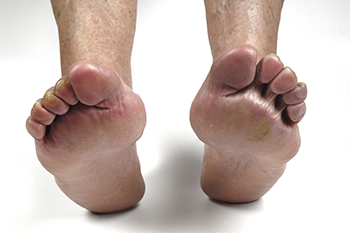
Rheumatoid arthritis, also known as RA, is a disease that causes pain and problems in joints and other areas of the body. One common area it affects is the feet. When someone has RA, their feet can hurt, and they may have trouble moving them. RA can cause the joints to swell, and they may become damaged over time. In the beginning, the signs of RA can mimic a host of other joint problems. Getting RA diagnosed quickly is important, as treating it early can help prevent joint damage and make the disease easier to control. If you have pain in your foot or ankle joints, it is strongly suggested that you visit a podiatrist to have an evaluation, a proper diagnosis, and correct treatment started.
Because RA affects more than just your joints, including the joints in your feet and ankles, it is important to seek early diagnosis from your podiatrist if you feel like the pain in your feet might be caused by RA. For more information, contact Howard Waxman, DPM of Pleasant Valley Podiatry. Our doctor will assist you with all of your podiatric concerns.
What Is Rheumatoid Arthritis?
Rheumatoid Arthritis (RA) is an autoimmune disorder in which the body’s own immune system attacks the membranes surrounding the joints. Inflammation of the lining and eventually the destruction of the joint’s cartilage and bone occur, causing severe pain and immobility.
Rheumatoid Arthritis of the Feet
Although RA usually attacks multiple bones and joints throughout the entire body, almost 90 percent of cases result in pain in the foot or ankle area.
Symptoms
Diagnosis
Quick diagnosis of RA in the feet is important so that the podiatrist can treat the area effectively. Your doctor will ask you about your medical history, occupation, and lifestyle to determine the origin of the condition. Rheumatoid Factor tests help to determine if someone is affected by the disease.
If you have any questions please feel free to contact one of our offices located in Willoughby Hills and Broadview Heights, OH . We offer the newest diagnostic and treatment technologies for all your foot and ankle needs.
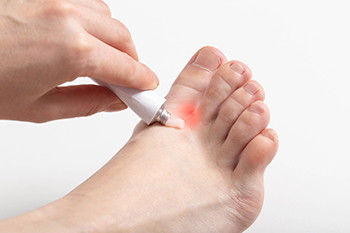
Athlete's foot, a common fungal infection of the skin, often affects the spaces between the toes. This condition is caused by various fungi, including trichophyton and epidermophyton, thriving in warm and moist environments such as locker rooms and swimming pool areas. Symptoms typically manifest as redness, itching, and a burning sensation, particularly between the toes. As the infection progresses, the skin may peel, crack, or develop blisters, contributing to discomfort. Athlete's foot can extend to the soles of the feet, causing scaling and thickening of the skin. In severe cases, the infection may spread to the toenails, leading to additional complications. Recognizing these symptoms is important for early intervention, as untreated athletes' foot can persist and potentially spread to other parts of the body. If you have symptoms of athlete’s foot, it is suggested that you contact a podiatrist who can offer you correct treatment options, which may include prescribed medicine.
Athlete’s foot is an inconvenient condition that can be easily reduced with the proper treatment. If you have any concerns about your feet and ankles, contact Howard Waxman, DPM from Pleasant Valley Podiatry. Our doctor will treat your foot and ankle needs.
Athlete’s Foot: The Sole Story
Athlete's foot, also known as tinea pedis, can be an extremely contagious foot infection. It is commonly contracted in public changing areas and bathrooms, dormitory style living quarters, around locker rooms and public swimming pools, or anywhere your feet often come into contact with other people.
Solutions to Combat Athlete’s Foot
Athlete’s foot can cause many irritating symptoms such as dry and flaking skin, itching, and redness. Some more severe symptoms can include bleeding and cracked skin, intense itching and burning, and even pain when walking. In the worst cases, Athlete’s foot can cause blistering as well. Speak to your podiatrist for a better understanding of the different causes of Athlete’s foot, as well as help in determining which treatment options are best for you.
If you have any questions please feel free to contact one of our offices located in Willoughby Hills and Broadview Heights, OH . We offer the newest diagnostic and treatment technologies for all your foot and ankle needs.
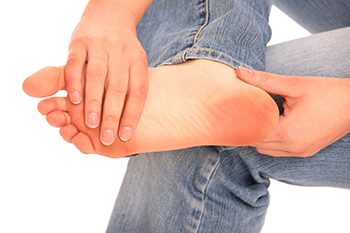
Exploring a different country on foot, whether in the tranquil early morning or during the enchanting twilight hours, offers a unique experience. However, this active exploration can come with challenges, particularly when navigating a city's cobblestone streets. Walking extensively can lead to foot pain, with common issues including plantar fasciitis and Achilles tendinopathy. These conditions are often caused by overuse, wearing inadequate footwear, or tight and weak muscles. Plantar fasciitis, for example, manifests as a sharp pain in the heel as a result of overburdening the feet. Achilles tendinopathy presents as pain in the lower leg and is often caused by tight calves and wearing unsupportive shoes. To prevent and treat these issues, it is suggested that prior to your trip, you make an appointment with a podiatrist to discuss options such as using custom-made orthotics and targeted stretching and strengthening exercises that may help you to avoid foot pain so you can enjoy your vacation
Foot Pain
Foot pain can be extremely painful and debilitating. If you have a foot pain, consult with Howard Waxman, DPM from Pleasant Valley Podiatry. Our doctor will assess your condition and provide you with quality foot and ankle treatment.
Causes
Foot pain is a very broad condition that could be caused by one or more ailments. The most common include:
Diagnosis
To figure out the cause of foot pain, podiatrists utilize several different methods. This can range from simple visual inspections and sensation tests to X-rays and MRI scans. Prior medical history, family medical history, and any recent physical traumatic events will all be taken into consideration for a proper diagnosis.
Treatment
Treatment depends upon the cause of the foot pain. Whether it is resting, staying off the foot, or having surgery; podiatrists have a number of treatment options available for foot pain.
If you have any questions, please feel free to contact one of our offices located in Willoughby Hills and Broadview Heights, OH . We offer the newest diagnostic and treatment technologies for all your foot care needs.
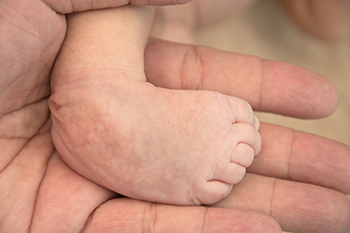
The journey of infancy unveils the uniqueness of every child, including the diverse ways their little feet may develop. Clubfoot and metatarsus adductus stand out as congenital foot conditions that influence the early stages of a child's mobility. Clubfoot presents as a deformity where the foot turns inward and downward, affecting the bones, muscles, tendons, and ligaments. Conversely, metatarsus adductus, involves a curved or turned in position of the front part of the foot. Both conditions are noticeable from birth and can be attributed to a combination of genetic and environmental factors. While clubfoot necessitates gentle manipulations and casting to guide the foot into proper alignment, metatarsus adductus often resolves with stretching exercises and wearing proper footwear. Understanding these congenital foot conditions empowers parents and podiatrists to initiate timely interventions, providing the best foundation for a child's healthy and active future. If your child has been born with one of these foot conditions, it is strongly suggested that you are under the care of a podiatrist who can promptly begin the correct treatment.
Congenital foot problems require immediate attention to avoid future complications. If you have any concerns, contact Howard Waxman, DPM of Pleasant Valley Podiatry. Our doctor can provide the care you need to keep you pain-free and on your feet.
Congenital foot problems are deformities affecting the feet, toes, and/or ankles that children are born with. Some of these conditions have a genetic cause while others just happen. Some specific foot ailments that children may be born with include clubfeet, polydactyly/macrodactyly, and cleft foot. There are several other foot anomalies that can occur congenitally. What all of these conditions have in common is that a child may experience difficulty walking or performing everyday activities, as well as trouble finding footwear that fits their foot deformity. Some of these conditions are more serious than others. Consulting with a podiatrist as early as possible will help in properly diagnosing a child’s foot condition while getting the necessary treatment underway.
What are Causes of Congenital Foot Problem?
A congenital foot problem is one that happens to a child at birth. These conditions can be caused by a genetic predisposition, developmental or positional abnormalities during gestation, or with no known cause.
What are Symptoms of Congenital Foot Problems?
Symptoms vary by the congenital condition. Symptoms may consist of the following:
Treatment and Prevention
While there is nothing one can do to prevent congenital foot problems, raising awareness and receiving neonatal screenings are important. Early detection by taking your child to a podiatrist leads to the best outcome possible.
If you have any questions please feel free to contact one of our offices located in Willoughby Hills and Broadview Heights, OH . We offer the newest diagnostic tools and technology to treat your foot and ankle needs.
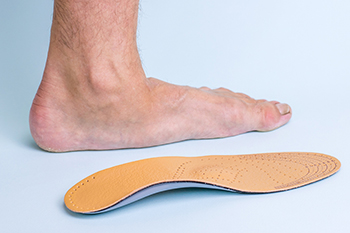
Pes planus, commonly known as flat feet, occurs when the foot's arch does not develop or collapses, leading to the entire sole touching the floor. Children typically have flat feet, and their arch develops as they grow into toddlerhood. It usually suffices for podiatrists to provide shoe advice for the majority of kids who have this condition. However, for kids with hypermobility or hypotonia, further intervention might be required. Flat feet typically emerge as the infant's fat pad recedes and motor skills progress, but sometimes arch development is impeded by factors such as calf muscle tightness or ligament hypermobility. While flat feet often do not trouble children, they can eventually cause gait changes, clumsiness, or pain. Early treatment is important to prevent these types of issues. If your child has flat feet that are causing problems, it is suggested that you make an appointment with a podiatrist for appropriate treatment.
Flatfoot is a condition many people suffer from. If you have flat feet, contact Howard Waxman, DPM from Pleasant Valley Podiatry. Our doctor will treat your foot and ankle needs.
What Are Flat Feet?
Flatfoot is a condition in which the arch of the foot is depressed and the sole of the foot is almost completely in contact with the ground. About 20-30% of the population generally has flat feet because their arches never formed during growth.
Conditions & Problems:
Having flat feet makes it difficult to run or walk because of the stress placed on the ankles.
Alignment – The general alignment of your legs can be disrupted, because the ankles move inward which can cause major discomfort.
Knees – If you have complications with your knees, flat feet can be a contributor to arthritis in that area.
Symptoms
Treatment
If you are experiencing pain and stress on the foot you may weaken the posterior tibial tendon, which runs around the inside of the ankle.
If you have any questions please feel free to contact one of our offices located in Willoughby Hills and Broadview Heights, OH . We offer the newest diagnostic and treatment technologies for all your foot and ankle needs.
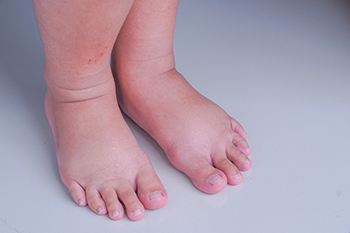
Lymphoedema is a condition where the legs or feet swell due to fluid buildup because the body's lymphatic system, which functions similarly to veins, is struggling to remove it. This swelling is called edema and can happen when you do not move enough, such as after sitting for long periods during a flight. Persistent swelling of the feet, swelling that lasts over three months, is known as chronic edema, which suggests the beginning of lymphatic failure or early lymphoedema. If left untreated, chronic foot edema can cause skin changes, deeper tissue damage, and increase the risk of infections such as cellulitis. It is often associated with chronic venous insufficiency. Various factors can contribute to lymphoedema, including genetics, obesity, inactivity, vein problems, or damage from cancer treatments. Joint surgery may also impair lymphatic vessels, leading to lymphoedema. If you are experiencing swollen feet on a regular basis, it is suggested that you make an appointment with a podiatrist as quickly as possible to obtain treatment and prevent serious complications.
Swollen feet can be a sign of an underlying condition. If you have any concerns, contact Howard Waxman, DPM of Pleasant Valley Podiatry. Our doctor can provide the care you need to keep you pain-free and on your feet.
Swollen feet are a common ailment among pregnant women and people who stand or sit for extended periods. Aging may increase the possibility of swollen feet and patients who are obese often notice when their feet are swelling too. There may be medical reasons why swollen feet occur:
Swollen feet can also be caused by bone and tendon conditions, including fractures, arthritis, and tendinitis. Additionally, there may be skin and toenail conditions and an infection may cause the feet to swell. Patients who take medicine to treat high blood pressure may be prone to getting swollen feet.
Many patients elevate their feet to help relieve the swelling and this is generally a temporary remedy. When a podiatrist is consulted the reason behind the swelling can be uncovered and subsequently treated.
If you have any questions please feel free to contact one of our offices located in Willoughby Hills and Broadview Heights, OH . We offer the newest diagnostic tools and technology to treat your foot and ankle needs.